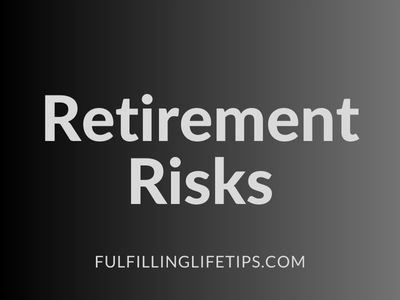Retirement is a phase of life that most people look forward to. It is a time when you can relax and enjoy the fruits of your labor. However, retirement also comes with its own set of risks. These risks can have a significant impact on your retirement income, assets, and overall financial security. In this article, we will explore the different types of retirement risks and how to mitigate them.

Types of Retirement Risks
There are various types of retirement risks, and they can be broadly classified into the following categories:
1. Longevity Risk
Longevity risk refers to the risk of outliving one’s retirement savings. With increasing life expectancies, retirees need to ensure that they have enough savings to sustain their lifestyle for a longer period. Longevity risk can be mitigated by investing in annuities or other retirement income products that offer guaranteed income for life.
2. Inflation Risk
Inflation risk refers to the risk of rising prices reducing the purchasing power of retirement savings. As prices increase over time, the value of money decreases. Inflation risk can be mitigated by investing in assets that provide a hedge against inflation, such as stocks, real estate, or commodities.
3. Market Risk
Market risk refers to the risk of investment losses due to market volatility. A sudden drop in the stock market can have a significant impact on an individual’s retirement savings. Market risk can be mitigated by diversifying investments across different asset classes and avoiding excessive exposure to any single investment.
4. Health Care Risk
Healthcare risk refers to the risk of unexpected healthcare expenses that can deplete retirement savings. With increasing age, healthcare expenses can become a significant portion of retirement expenses. Health care risk can be mitigated by investing in long-term care insurance or by saving enough money to cover potential healthcare expenses.
5. The sequence of Returns Risk
A sequence of returns risk refers to the risk of investment losses during the early years of retirement. A market downturn during the first few years of retirement can have a significant impact on the longevity of retirement savings. Sequence of returns risk can be mitigated by investing in a diversified portfolio of assets that provide a steady stream of income.
How to Mitigate Retirement Risks
Retirement risks can be mitigated by taking appropriate steps during the pre-retirement and post-retirement phases. Some of the key steps are:
- Start Early: The best way to mitigate retirement risks is to start early. The earlier an individual starts saving and investing for retirement, the more time they have to accumulate wealth and ride out market volatility.
- Diversify Investments: Diversifying investments across different asset classes can help reduce market risk. Investing in a mix of stocks, bonds, and real estate can provide a balance between risk and return.
- Invest in Annuities: Investing in annuities can provide guaranteed income for life, thereby mitigating longevity risk. Annuities can be purchased from insurance companies and can be customized to meet an individual’s specific retirement needs.
- Save for Health Care Expenses: Health care expenses can be a significant portion of retirement expenses. Saving enough money to cover potential healthcare expenses can help mitigate healthcare risks. Alternatively, investing in long-term care insurance can provide coverage for unexpected healthcare expenses.
- Consult a Financial Advisor: Consulting a financial advisor can help individuals develop a retirement plan that takes into account their specific needs and goals. A financial advisor can help identify retirement risks and develop a plan to mitigate them.
Conclusion
Retirement risks can have a significant impact on an individual’s financial security. Understanding the different types of retirement risks and taking appropriate steps to mitigate them can help ensure a comfortable and secure retirement. It is important to remember that retirement planning is a long-term process, and it requires ongoing attention and monitoring. By staying informed and taking proactive steps to mitigate retirement risks, individuals can enjoy a secure and comfortable retirement.



